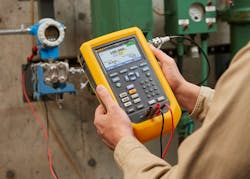Critical measurements for the calibration of process instrumentation
Process instruments are responsible for making critical measurements and controlling critical processes throughout a manufacturing facility. These instruments — pressure, flow and temperature; gauges, transmitters and sensors — all require precision and accuracy to properly monitor and control industrial processes. Calibration is a crucial part of ensuring process instrumentation has accurate, repeatable and consistent measurements for optimum process efficiency.
An inaccurate measurement from a process instrument can cause lost efficiency, additional energy expenditures and impact product quality — directly impacting revenue. Inaccurate measurements can also cause additional stress and wear on manufacturing processes. The best way to counteract these issues is by calibrating process instrumentation as part of a proactive maintenance program.
Calibration parameters
Every processing facility will need to tailor its approach to calibration to match the needs of the process. Identifying critical process tolerances, calibration intervals and the test parameters required are key elements of an effective program. For every piece of processing equipment in a facility, these parameters must be set up.
- Tolerances: Define acceptable range for measurement errors.
- Intervals: Determine the frequency of calibration.
- Test points: Specific values the instrument is tested against.
- Test equipment with adequate measurement accuracies.
Identify critical instruments
Build out and document these test parameters and the measurements for each based on the criticality of the measurement, the equipment and the operational or regulatory requirements of the specific industry. Setting up a system of checking and identifying each of these allows for maximum uninterrupted facility operations.
Define calibration intervals
Following a regular calibration schedule for equipment is another critical aspect to ensuring measurements are accurate. Spot-checking or “bump checking” with a reference instrument, such as a precision thermometer or reference pressure gauge, can be a cost-effective way to ensure the accuracy of process instruments in between full calibrations.
Spot/bump checks are a great way to ensure critical equipment has not drifted in between calibrations, but it is still important to follow documented or manufacturers guidelines. Full calibrations should be completed comparing process instruments’ measurements to an external calibration instrument ideally, four times more accurate than the instrument being tested.
Calibration procedures
As part of an instrument calibration program, establish proper documented procedures and revision control. Establishing documented calibration procedures and practices is a huge step in ensuring accurate, repeatable measurements. Often, technicians work with practices set up years ago, using out-of-date equipment or regulations. As metrology, and measurement sciences improve, so should the processes being used.
Defining the correct calibration parameters for all the instruments in a plant will take time. It means measurements need to be recorded in a way that can analyze performance and drift over time. All of this ties back in to having an accessible baseline built out with good historical records, allowing for the understanding of the lowest, practical tolerances that can be maintained while balancing production, quality and scheduling.
Build a baseline
After identifying critical process measurement parameters, calibration intervals and the procedures to use, this information should be included as part of a baseline for each piece of critical equipment in a facility. This baseline helps teams understand the standard operating levels of the equipment, allowing for the analysis of results and adjustments as needed. As teams go through the process of performing a documented calibration using the same test points and the same measurements at regular intervals, teams will build up a measurement history of how critical equipment behaves over time.
A well-built baseline and history records also allows for teams to quickly identify abnormal behavior or out-of-tolerance measurements. Teams will know how the equipment usually acts, what tolerances have been set and what kind of measurements are within the norm. Being able to quickly see when it is not within that normal baseline can help mitigate issues before they get too large and cause unplanned downtime or quality issues.
Calibration management software
To tie together and manage baseline calibration measurements, subsequent calibrations and test equipment used, calibration software can help keep it all organized. Adding calibration software to the mix can ensure accurate calibration and traceability records while providing a paperless solution.
All instrumentation drifts regardless of make, model or how new. Based on the allowable measurement and control variability of various processes, each facility ends up with different specifications and calibration parameters tailored to the equipment. Calibration management software is the best way to manage and determine how equipment will drift or act over time once the baseline and subsequent calibration over time has been recorded. Referencing baseline and historical information in calibration software and using analytical tools and reports can help change maintenance practices from being reactive to proactive. Calibration management software helps automate the process of tracking and analyzing the data, notifying when calibrations need to be done and ensure consistency by storing the procedures used each time a calibration is performed. Calibration software is the key that can keep all this critical information available and ready to go to work.
No matter the specific process industry, accurate process measurements are critical to the safe, efficient and effective operation of processes. A good process instrument calibration program is crucial in keeping those measurements accurate.
A paperless instrumentation calibration process using a documenting field calibrator and calibration management software enables plant technicians, supervisors and planners reduce maintenance costs and optimize process operations.
Jim Shields is a process calibration product specialist at Fluke Corporation. He has worked in the field of electrical, temperature and pressure measurement for more than 35 years.
Jim Shields | process calibration product specialist at Fluke Corporation
Jim Shields is a process calibration product specialist at Fluke Corporation. He has worked in the field of electrical, temperature and pressure measurement for more than 35 years.





